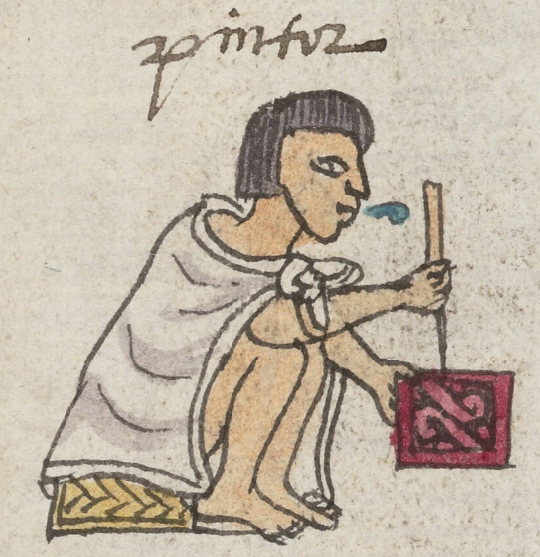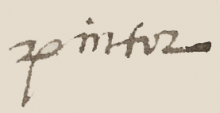tlacuiloliztli (Mdz70r)
This iconographic example appears to demonstrate the act of writing or painting, tlacuiloliztli, although it is not glossed as such. It is a square with back to back scrolls and small circles. The scrolls are reminiscent of speech scrolls. The border of the box containing the scrolls is red (tlapalli). A hand is shown holding a painting or writing instrument to the rectangle with the double opposing volutes.
Stephanie Wood
The person painting or writing is called a "pintor" (painter) in the gloss, which is what leads to the interpretation here of his work being a manuscript, a piece of writing/painting. The visual association with speech is another part of the reasoning. The warmth of the sun (and the verb tona) are also relevant here. Some scholars will identify this sign as representing the word ilhuitl (day) or tonalamatl (divinatory calendar).
The box recalls other pieces of writing, which tend to be contained as opposed to loose scrolls that emerge from people's mouths. The rectangular shape may convey the sense of a screenfold manuscript or book. The example, below, from the Codex Telleriano-Remensis has two adjoining rectangles, which may suggest segments of a screenfold. Boxes are drawn around calendrical year glyphs and are a significant part of the iconography of time telling. So, that could come into play here, too, if the manuscript is a divinatory almanac.
Elizabeth Hill Boone calls the enclosed scrolls of this record an ideogram for the "tonalamatl or sacred almanac of the days." She equates the symbol with "day," while also admitting that it does not bear a resemblance to a day, but the association is "culturally assigned." She puts this sign on an equal footing with the tonalli signs on folios 7 verso and 19 recto of the Codex Mendoza. [See: Stories in Red and Black, 2000, 35.] James Maffie states that the left-hand stone of the Piedras de los Reyes monument "depicts Cipactonal working on what one would think is a tonalamatl, supporting the interpretation of ilhuitl double opposing speech scrolls within a rectangular box as tonalamatl." He also notes how "Mikulska distinguishes the meaning of two opposing speech scrolls from two opposing speech scrolls within a rectangular box." (Personal communication, 1/12/2023.)
See the female version of the painter/writer from folio 30 recto of the Telleriano-Remensis. She is actively writing or painting on a two-part rectangle. One side has a design similar to this one for the painter. The left side has a shape that appears to be a quincunx (perhaps a sun), with four symmetrical parts and a center. It echoes the two paintings in the glyph for the name Cuilol (below). That shape might also tie into the day sign, suggesting an almanac. Alternatively, this is a flower, and the sign for painting.
Marc Thouvenot (2010, 184–185) identifies the boxed opposing speech scrolls in the Codex Mendoza as "ilhuia," adding that a subset of things having to do with writing (tlacuilolli) are associated with language (not just mainly images or visual things). But he also identifies the same sign of opposing speech scrolls in the Codex Xolotl as cemilhuitzin. There, it has an added sign which seems to contribute to it being seen as "a day" (in the reverential) which brings us back to the book of the days. But, Cemilhuitzin was also a person (hence the reverential), a "traitorous relative" of Nezahualcoyotl (according to Jerome Offner, 2016, 107), and one of the authors of a text of Chichimec history that relates to the Codex Xolotl, according to José Rabasa (2016, 180), found in studies published in Galen Brokaw and Jongsoo Lee, ed., Fernando de Alva Ixtlilxochitl and His Legacy (2016).
In a personal communication James Maffie adds further: "Mikulska and Whittaker defend the existence of a link between ilhuitl and ilhuia not on the basis of their shared meaning but rather on the basis of the shared sound of the words “ilhuitl” and “ilhuia.” [Note: Mikulska, Tejiendo destinos, 2015, 51.] Gordon Whittaker describes the ilhuitl glyph “with its embedded, interacting speech scrolls for phonetic ilhui (from ilhuia “say [to someone].” [Note: Embolding is by Whittaker. See his Deciphering Aztec Hieroglyphs, 2021, 98.]
See the drawings by John Montgomery published by FAMSI, Inc., which group tonalli, ilhuitl, and the two opposing speech scrolls as being semantically and phonetically connected and pointing to the divinatory calendar, the tonalamatl.
Finally, the four dots around the corners of this glyph may be like the dots suggesting shimmer on a range of signs, such as chalchihuitl, xihuitl, tezcatl, teocuitlatl, tonatiuh, etc. Possibly the same four dots, but by themselves, are employed to say "tonalli" as shown below.
See also the article on vibrance in glyphs (on the left).
Stephanie Wood
pintor
c. 1541, or by 1553 at the latest
Stephanie Wood
writing, escritura, manuscript, manuscrito, calendarios, calendars, almanacs, ilhuitl, tonalli, tonalamatl, cuilolli, días, days, calendars, xiuhpohualli, año, turquesa, xihuitl, tlacuilolli
This stone carving of what appears to be a pair of glyphs that refer to painting and writing (or tonalli and ilhuitl, referring to sun/day, and therefore annals), is located in the Museo de Escultura Mexica at the archaeological site of Santa Cecilia Acatitlan (juris. Tlalnepantla, Mexico City). This visual diphrasism repeats around what was a cuauhxicalli (container for hearts) that was repurposed as a baptismal font, according to the interpretation in the museum. In the center bottom rung of the carvings is the square with two back-to-back speech scrolls with circlets in four points around the perimeter, much like the glyph shown above. Photo by Stephanie Wood, 13 August 2023.
tlacuiloliz(tl), the act of painting or writing, https://nahuatl.wired-humanities.org/content/tlacuiloliztli
tetlacuilo, a sculptor, https://nahuatl.wired-humanities.org/content/tetlacuilo
ilhui(tl), day, https://nahuatl.wired-humanities.org/content/ilhuitl
ilhuia, to tell or say something to someone, https://nahuatl.wired-humanities.org/content/ilhuia
La escritura, el manuscrito
Stephanie Wood
Codex Mendoza, folio 70 recto, https://digital.bodleian.ox.ac.uk/objects/2fea788e-2aa2-4f08-b6d9-648c00..., image 150 of 188.
Original manuscript is held by the Bodleian Libraries, University of Oxford, MS. Arch. Selden. A. 1; used here with the UK Creative Commons, “Attribution-NonCommercial-ShareAlike 3.0 License” (CC-BY-NC-SA 3.0)










